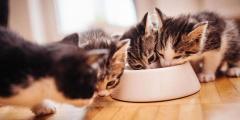
Kittens are always on the move - hiding in nooks and crannies, chasing pieces fluff and even answering nature’s call without a warning. Because your kitten is always keeping busy, it’s important to take the time to ensure she’s getting the nutrition she needs. That’s why we’ve put together these helpful tips on how to feed a kitten.
Kitten feeding tips
Before you continue reading, we’d like to make a quick note about newborn kittens. Newborn kittens get all of their nutrition from nursing, or if separated from their mother, from a milk replacement. They may require special care as well. Please contact your veterinarian for information about how to take care of newborn kittens.
Follow the tips below to learn how to feed a kitten properly. Please note that these feeding tips are for kittens that are ready to transition from nursing to dry or wet kitten food and are around 3-5 weeks of age.
Transition slowly to a solid diet
When your kitten is 3-7 weeks old, try setting out moistened kitten food for them to nibble on. To prepare the moistened food, mix one part of warm water and three parts dry or canned kitten food. The consistency of the moistened food should look similar to oatmeal. Over the next week or so, gradually decrease the amount of water and increase the amount of food to help with the transition.
Feed 100% complete and balanced kitten food
Kittens need special nutrition – and lots of it! They’re growing quickly and always playing, which means they require two to three times more protein, fat and other nutrients as compared to adult cats. Make sure to check your bag of kitten food to be certain that it provides 100% complete and balanced nutrition for kittens. If you have any questions, ask your veterinarian.
Let your kitten get used to the food
At first, your kitten may play with her food or even step in her food dish. If she does so, remember:
- She’s a kitten – everything is a toy to her.
- Her concept of food is still very fluid at this point.
Be patient! Keep a moist cloth at hand for a quick clean up, and make sure your kitten stays warm and dry.
Keep an eye on the food dish
Monitor your kitten’s food dish and make sure to switch out the food multiple times per day, especially when serving wet or moistened dry food. While kittens have huge appetites, they still may turn their noses up at food left out for more than a few hours. Frequent switch-outs also ensure a lower risk of contamination.
Water is vital
While water is not food, it is crucial when feeding your kitten. Your kitten’s body mass is 70 to 80 per cent water. The water in your kitten’s wet food and in moistened dry food works to help keep her hydrated, however, it is no substitute for fresh water. Make sure your kitten has access to plenty of clean water at all times, and that her water bowl is refilled at least once a day.
Feed kitten food until your kitten is one year old
Your kitten will start to look like a full-grown adult cat at about eight or nine months of age. But don’t be deceived by looks, your kitten still has a lot of growing and developing to do. It’s important to continue feeding kitten food for a full 12 months before transitioning to adult cat food.
Look out for signs of illness, including loss of appetite
Healthy kittens love to eat, so if you notice your kitten showing no interest in her food, call your veterinarian immediately. The first several weeks of a kitten’s life can test her immune system, and there is a higher risk of illness.
We hope that these tips helped you learn how to feed a kitten and ensure that she gets all the nutrition she needs to play and thrive. We just have one more tip for you: enjoy every last adorable moment while it last. Before you know it, your little kitten will be an amazing cat!
Related articles



